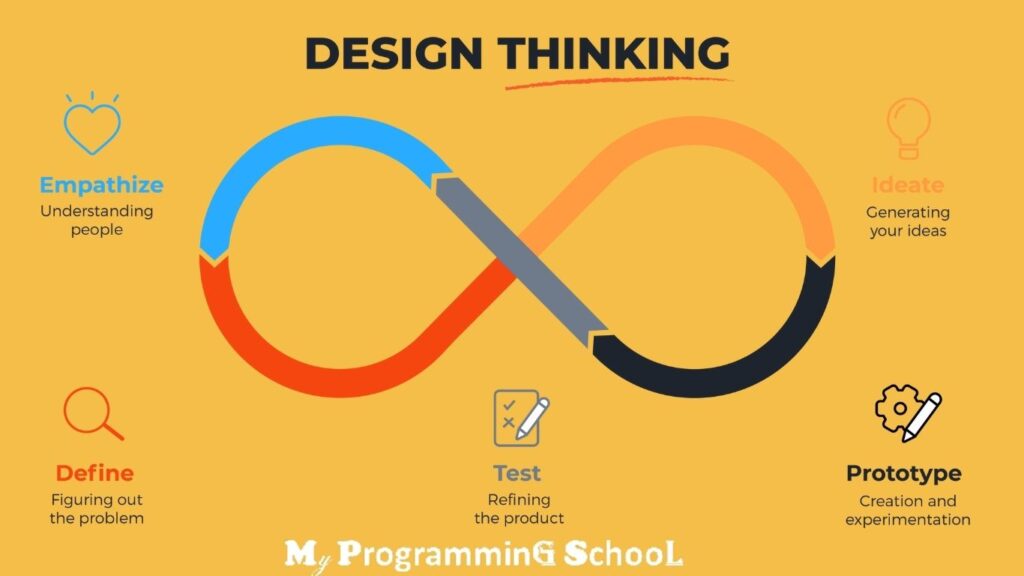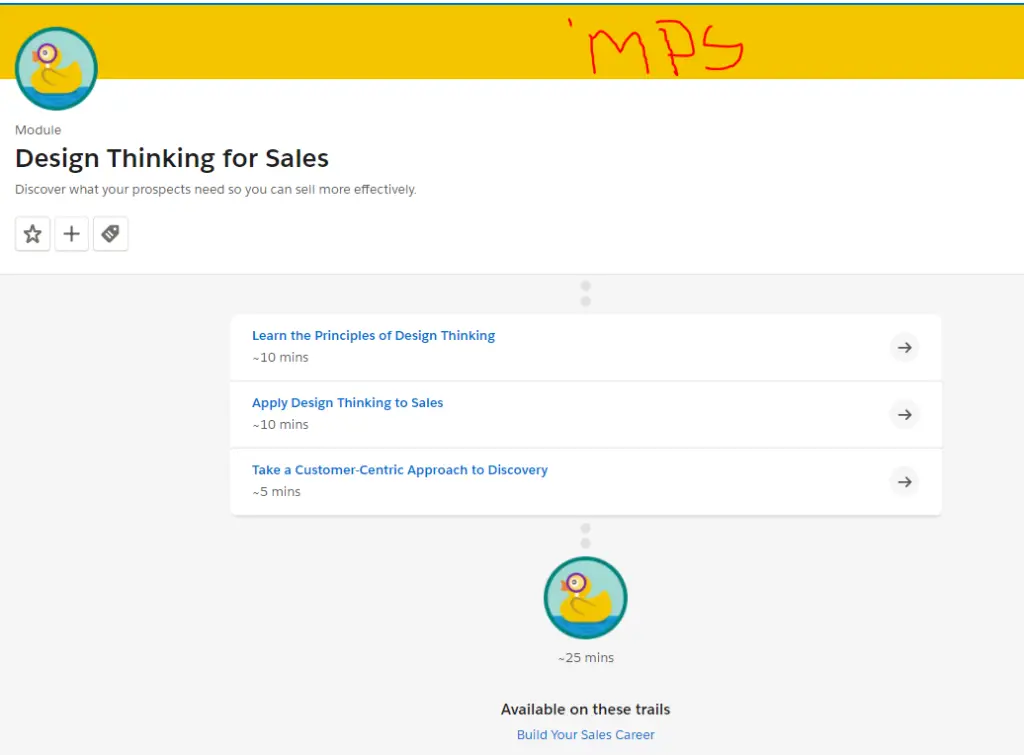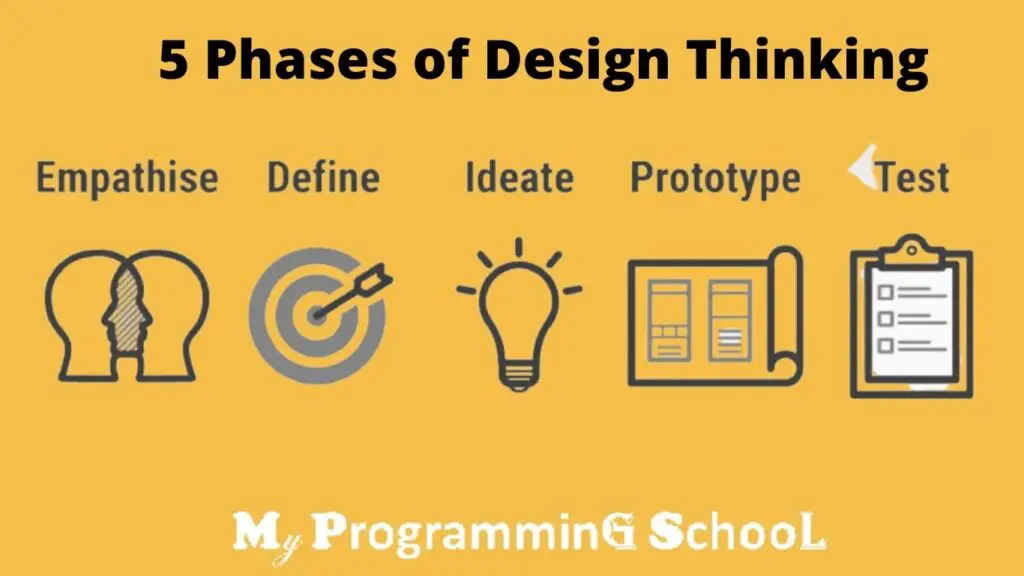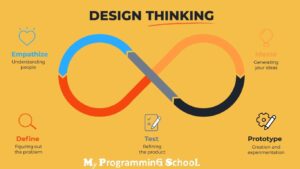Principles Of Design Thinking is about creating solutions for human needs. It emphasizes that solutions to complex problems require not just logic but also creativity and imagination to be integrated into the process of designing a solution. Design thinking is a creative and human-centered approach to problem-solving which combines the best design tools with an empathy for people, and an understanding of business needs to create innovative ideas.

Design thinking is now used by many organizations around the world including Dongsung Motor (the largest automobile manufacturer in Korea), Google, GE, IDEO, Honda, Facebook, Apple, NASA, and Toyota. Design thinking helps us think conspicuously, act diligently and create effectively. Design thinking has four stages: empathize, define concept, ideate, and prototype.
#1.Learn the Principles of Design Thinking

Q1)What is design thinking?
I)A way to create solutions that are aesthetically pleasing
II)A linear approach to solving problems
III)A creative problem-solving process used for innovating
IV)A software feature for design teams
[bg_collapse view=”button-green” color=”#4a4949″ expand_text=”Show Answers” collapse_text=”Hide Answers” ]
III)A creative problem-solving process used for innovating
[/bg_collapse]
Q2)What are core principles related to design thinking?
I)Seek a deep empathy with end-users.
II)Test solution ideas rapidly.
III)Draft a robust business case and immediately execute.
IV)A and B
V)B and C
[bg_collapse view=”button-green” color=”#4a4949″ expand_text=”Show Answers” collapse_text=”Hide Answers” ]
IV)A and B
[/bg_collapse]
#2.Apply Design Thinking to Sales
Q1)How does design thinking benefit salespeople?
I)Design thinking helps salespeople focus on their company’s products and services.
II)Design thinking helps orient sellers to their customers’ business problems.
III)Design thinking helps sellers navigate complex sales environments.
IV)A and C
V)B and C
[bg_collapse view=”button-green” color=”#4a4949″ expand_text=”Show Answers” collapse_text=”Hide Answers” ]
V)B and C
[/bg_collapse]
Q2)How can design thinking help sales people win deals?
I)By crafting a well designed legal agreement
II)By encouraging customers to start small to build confidence
III)By designing incentives and discounts that make solutions more attractive
IV)A and B
V)B and C
[bg_collapse view=”button-green” color=”#4a4949″ expand_text=”Show Answers” collapse_text=”Hide Answers” ]
II)By encouraging customers to start small to build confidence
[/bg_collapse]
#3.Take a Customer-Centric Approach to Discovery
Q1)True or false: CCD only works for B2B companies.
I)True
II)False
[bg_collapse view=”button-green” color=”#4a4949″ expand_text=”Show Answers” collapse_text=”Hide Answers” ]
II)False
[/bg_collapse]
Q2)Know the customer refers to what?
I)Researching a customer to orient to their business.
II)Finding ways to walk in the end user’s shoes.
III)Showing genuine interest in the customer’s business.
IV)Building a social network composed of all the customer’s employees.
[bg_collapse view=”button-green” color=”#4a4949″ expand_text=”Show Answers” collapse_text=”Hide Answers” ]
I)Researching a customer to orient to their business.
[/bg_collapse]
what are the principles of design thinking?
Design thinking is the process of creating something (solution) that will be sold to customers. A designer must think about how their product will be used in order to create something that’s not only functional but also desirable.
Design thinking is grounded in exploration, discovery, and experimentation. Designers are always learning about new ways to do things, and achieve the best result. This often means designing new methods.
Designers work in interdisciplinary teams, with people from different fields coming together to solve problems. This means the designer may not know the right answer ahead of time, which is why they work with others to explore, create, and develop design solutions.
what are the 7 key principles of design thinking
Design thinking is a way of thinking that considers the needs of different people, probable problems, and possible solutions.
Design thinking is a way of thinking that considers the needs of different people, probable problems, and possible solutions. It is an iterative process that involves six steps: research, ideation, prototyping, testing, presentation, and implementation. Below are the twelve principles of design thinking.
1) Designers should see themselves as both humanists and rationalists. They should be able to understand both people and the process through an open perspective.
2) Designers should reject the idea of designing for what people think they want and instead design for what people actually need.
3) Designers should reject the idea of designing for what people think they want and instead design for what people actually need.
A central goal of design is to understand people’s needs, problems, and desires, even if that means they aren’t articulated.
4) Designers should not create anything they wouldn’t want to use themselves.
5) Designers are they are most creative when they are designing for someone else.
6) Designers should work collaboratively.
7) Every design has constraints, and designers should work to understand and embrace them rather than resent them.
Design is about more than the final thing that is designed. Design is about the process and how that process continually tries to find a better way to achieve a particular goal, and it is through this process that original ideas and new ways of solving problems come.
What exactly is design thinking?
“Design thinking” is a methodology for solving problems by applying human-centered design to generate empathy with customers and potential users, and tools like rapid prototyping, brainstorming, and visual thinking to generate and evaluate many possible solutions.
What are the 5 stages of design thinking?
Design thinking is a popular term to describe a problem-solving process that starts with empathy and then moves through a series of steps that help generate a solution.

The five stages of design thinking are:
Empathize: Explore the situation from the point of view of the people who will use the designs.
Define: Identify the problem or opportunity.
Ideate: Generate as many ideas as possible.
Prototype: Try out the top ideas.
Test: Test the ideas to see if they work.
The design thinking process is helpful for making sure you don’t inadvertently overlook the needs of the people who will use your creation. It also provides a structure for creativity and problem-solving. Design thinking is the process of looking at a problem from the perspective of the person who will be using the design. There are five phases of design thinking. These are Understand, Ideate, Prototype, Test, and Validate. The first two steps, Empathize and Define, are to identify the problem or opportunity. The last three are about implementation.
What is an example of design thinking?
Design thinking is a process that has been used for decades in fields such as architecture, engineering, and product design, but it has had its most recent success in the world of marketing. This process centers on empathy for the end-user of a product or service, whether it be a customer or someone on the other end of a sales pitch. One of the most common examples of design thinking in the marketing world is the experience map. This map takes into consideration all of the points where a customer may interact with a product or service.
All the way from the marketing campaign to the delivery of the service. It also considers where the customer may have a “moment of truth.” One example of this is when a consumer has to input their personal information at checkout. When it is time to input their credit card information, the customer either feels trusting of the e-commerce site or feels uneasy because there was not enough trust. Design thinking is a process that has been used for decades in fields such as architecture, engineering, and product design, but it has had its most recent success in the world of marketing. This process centers on empathy for the end-user of a product or service, whether it be a customer.
What are the 4 D’s of design thinking?
Design Thinking is a process that will help organizations find creative solutions to real-world problems.
It’s a process that goes beyond the limitations of the status quo to identify new ways to create, manufacture, and distribute goods and services.
The four Ds of Design Thinking are:
- – Different
- – Disruptive
- – Digital
- – Delightful
Design thinking was first popularized by a man named David Kelley. David Kelley is a designer and the founder of the company IDEO. He currently teaches design at Stanford University.- David Kelley introduced the four steps to designing thinking: Empathize, Define, Ideate, Prototype.
What are the 4 P’s of design thinking explain?
The 4 P’s of design thinking explained
A design thinking approach can be very useful for businesses as it encourages creativity and innovative thinking. Design thinking focuses on the process of developing innovative products, services, and business models. The 4 P’s -Prototyping, Empathy, Partnering, and Play- form the basis for the design thinking process.
1. Prototyping: prototypes are used to streamline and improve the design and prioritize the most important aspects of the design.
2. Empathy: designing for empathy is not about aesthetics, but rather discovering what people really need and then designing accordingly.
3. Partnering: partnering with different organizations maximizes creativity and allows for different perspectives to develop design solutions.
4. Play: playful activities allow for thought to break free from daily life and free the mind to creatively explore aspects of the design.
is design thinking a linear process
Design thinking is a linear process
Design thinking will help get to the root of a problem and come up with solutions. Design thinking is a linear process that will help get to the root of a problem and come up with solutions. Design thinking makes it possible to open up the box and see the problem in a different light.
is design thinking important
Design Thinking is an important skill for businesses. Design thinking can be important in solving problems for companies. Design thinking is not just about making things look good, it is about creating original solutions to problems. It is about thinking in color, shapes, and sound, in addition to what you see. Design thinking is an idea that comes from the design industry.
where can design thinking be applied?
Design thinking can be applied to many different fields such as changing the way we look at challenging problems and evaluating new perspectives. Design thinking is an approach to solving problems by breaking them down into their component parts and reframing them as projects. Design thinkers work in cross-disciplinary teams to involve all stakeholders and to provide a fresh perspective on a problem, and then they come up with and test solutions.
how can design thinking helps business?
Design thinking in business can help in various ways. One of these ways is that it helps in the decision-making process in the business. It helps in this sense because it can provide a more creative approach to the process. Creative approaches are needed because they can help to make the best decision possible. It can also be helpful because it can help to ensure that all facts are considered in the decision-making process. Another way that design thinking in business can be helpful is by helping to generate new ideas. Design thinking can help to think of new ideas in order to improve the business. And lastly, design thinking may be helpful by developing prototypes.
how do design thinking and innovation relate?
Do design thinking and innovation go hand in hand?
Design thinking and innovation seem to go hand-in-hand. They are both about solving problems and finding new and innovative solutions to problems. Design thinking is a process or skill that helps you solve problems. Innovation is a set of new ideas that makes a difference. Design thinkers tend to be innovative because the design thinking process focuses on solutions.
how to do design thinking better?
Since it is a common practice for people to do Design Thinking, this blog post will explain the process of design thinking and steps to do it better. As a result, someone who is new to design thinking can learn a little bit more about it and how to do it better. It will also provide both new and experienced people with the same information.
Design thinking is a creative and systematic approach to solving problems that can be summarized by five principles: empathize, define, ideate, prototype, and test. Design thinking is a creative and systematic approach to solving problems.
how design thinking is different from traditional thinking?
It was a time like any other. I was sitting at my desk, brainstorming for ways to increase my company’s efficiency and dominate the market. I didn’t really think about what I was doing and by the end of the day, I was feeling quite frustrated and tired. I knew that I had to come up with an idea and quickly. I had read in one of the articles my company sends me that design thinking is different from traditional thinking.
First of all, in traditional thinking, traditional thinkers work on one problem at a time. They focus on one issue, one person, or one idea at a time. Design thinkers, on the other hand, work on many problems at once. They focus on many issues, many people, or many ideas at once. They do more than one thing as they’re working as opposed to doing as little as possible. In addition, design thinkers are always thinking about what to do next. They make sure to finish a task, but more importantly, they make sure the task is complete.
Design thinkers come from different perspectives. They always look for a solution to a problem. They break a problem down and solve it one step at a time. They find a more efficient way to accomplish a task.
when design thinking started?
Design thinking has been around for a very long time and even before it was known as design thinking, there were plenty of people using creative processes to solve problems. In 1973 Tom Kelley and David Kelley, founders of Ideo, published their book, Creative Confrontations, which showcases their view on design thinking. In 1938, Henry Dreyfuss invented the revolving door because he wanted to make the door as wide as the wall to avoid unnecessary trip hazards.
why design thinking is important?
Design Thinking at a Glance
Design thinking is a design methodology that merges the skills of a generalist, global problem-solver with a deep understanding of user needs. It is a fundamentally human-centered and empathetic approach to problem-solving. It is an approach to the design process that starts with empathy and often employs prototyping as a technique to test ideas and as a tool to guide the design process.
Design Thinking as a “Practice”
The term “design thinking” was first used by educators and design thinkers in the 1980s. Design thinkers work with many different types of problems and industries and come from various disciplines and diverse backgrounds. Design thinking is a multifaceted and highly flexible practice with many methods and principles.
why design thinking is important for business?
Design Thinking is about combining the design profession’s breadth of knowledge with strategic business thinking to innovate with purpose. Design Thinking is a powerful tool for innovation in the business world because it allows organizations to take a holistic approach to solve problems. Designers can use creativity, empathy, and collaboration to transform business challenges into problems that can be solved.
One of my favorite examples of design thinking in business is Airbnb, they recently redesigned their website to give users an easier and more intuitive interface, making it easier for tourists to book accommodations. Airbnb wanted to make the process of booking accommodations easier for their users, so they turned to design thinking to develop their new website.
why design thinking is important for innovation?
The design thinking process is important for innovation because it shows the user’s needs and desires, which other processes fail to do. Design thinking emphasizes creativity, collaboration, and iteration, which are all essential to innovation, as well as the output of the process is participatory.
why we need design thinking?
The keys to design thinking are creativity, empathy, and inspiration.
Creativity.
Creativity is the ability to make ideas happen. Designers create new products and services with guided imagery, which is their natural desire to make an idea like paint. It is the driving force for creativity. It is the ability to make connections between concepts and experiences, and tailor them for a specific group of people.
Empathy.
Empathy is the ability to understand people’s perspectives, which is one of the most important traits in design. Designers need to be able to put themselves in minds of the person who will be using their product. Designers use empathy to figure out what people need, want, etc.
Related Articles:
- What Is Audience Segmentation Strategy, Analysis, Tools With An Example
- Quick Start: Deploy A Java App On Heroku
- General Courses: Accountability And Delegation
- General Course: Blockchain Basics, Bitcoin, Cryptocurrency, Technology, Types
- General Courses: Culture Of Feedback, Types, Benefit, Important
- General Courses: Cyber Resilience
- General Courses: Demo Storytelling
- General Course: Digital Banking Basics-MPS
- General Courses: Demo Delivery Essentials
- General Courses: Google Analytics Basics
- General Courses: Great Management
